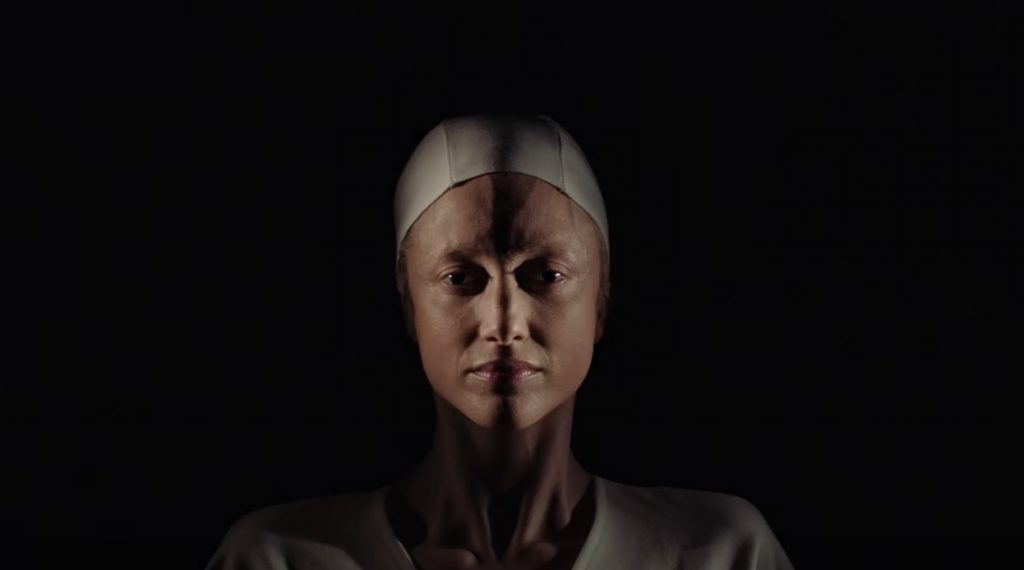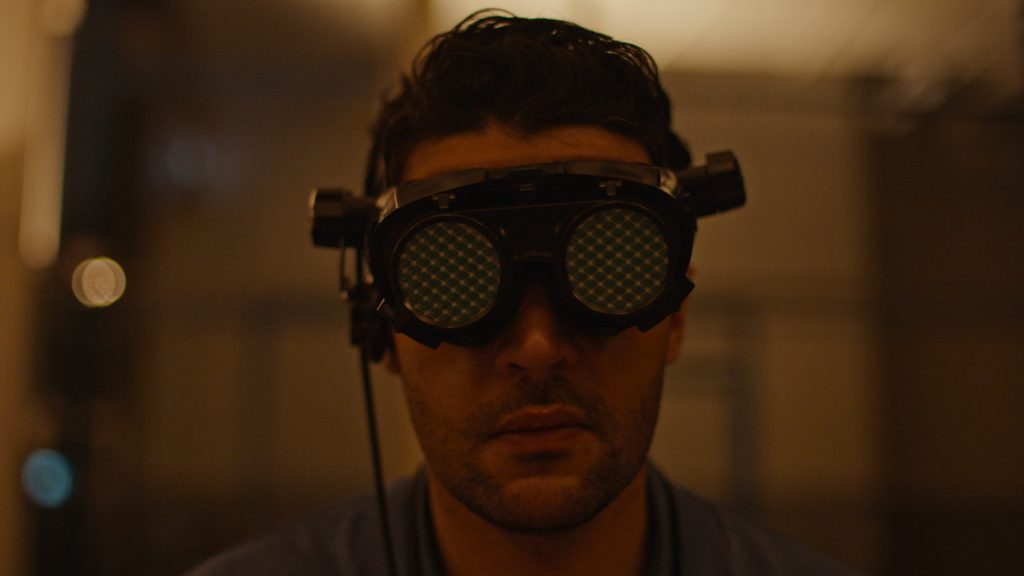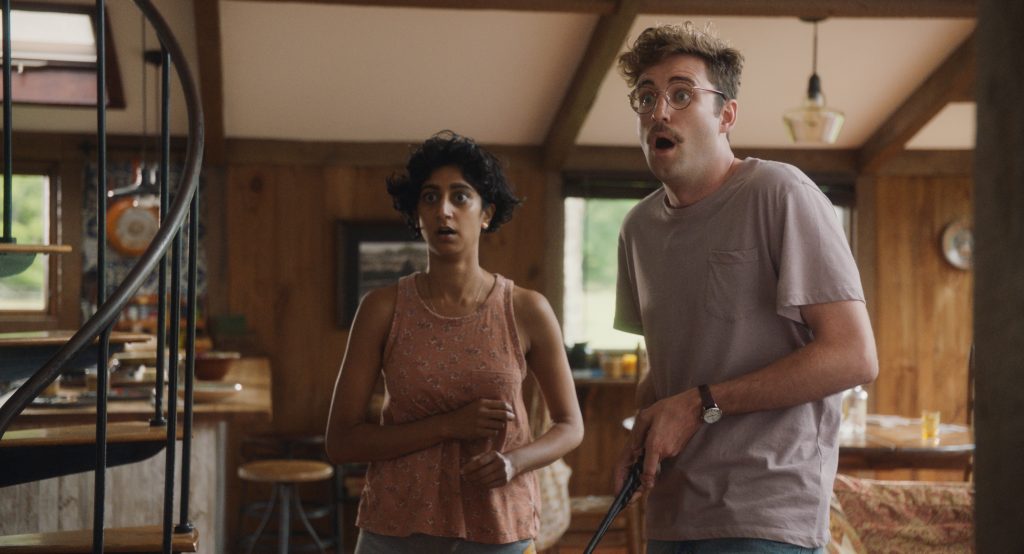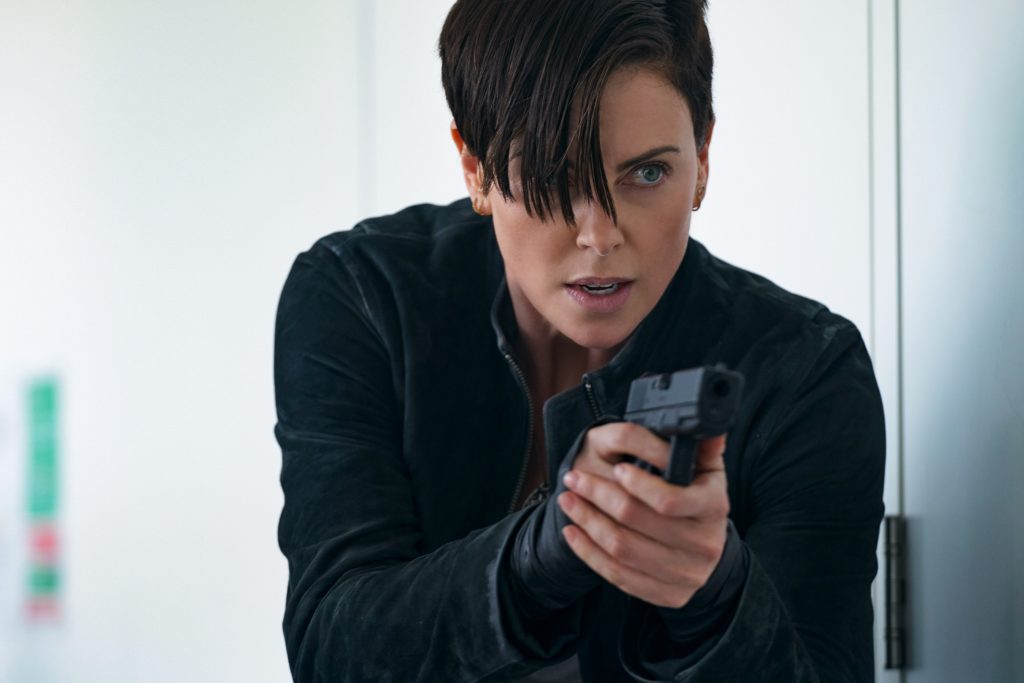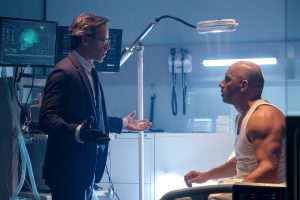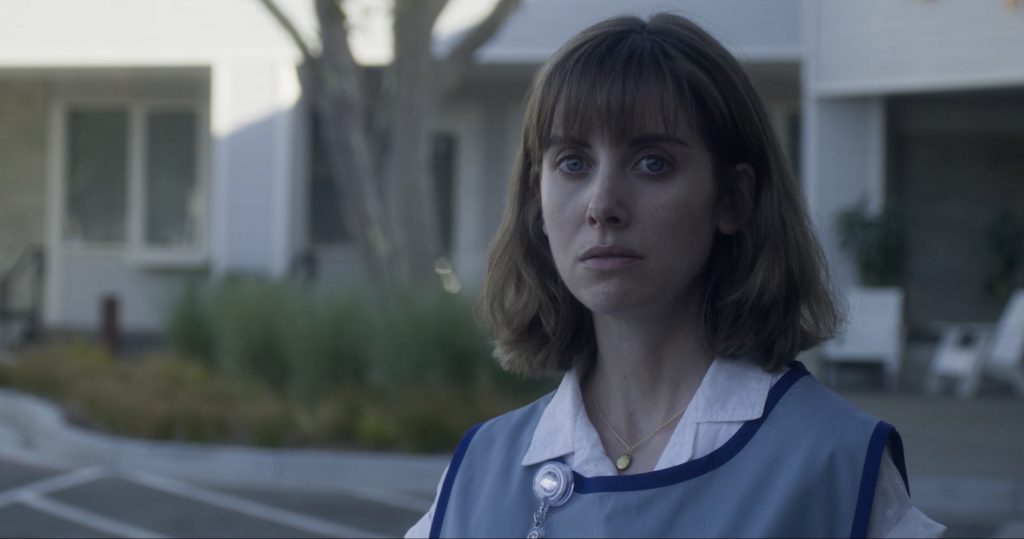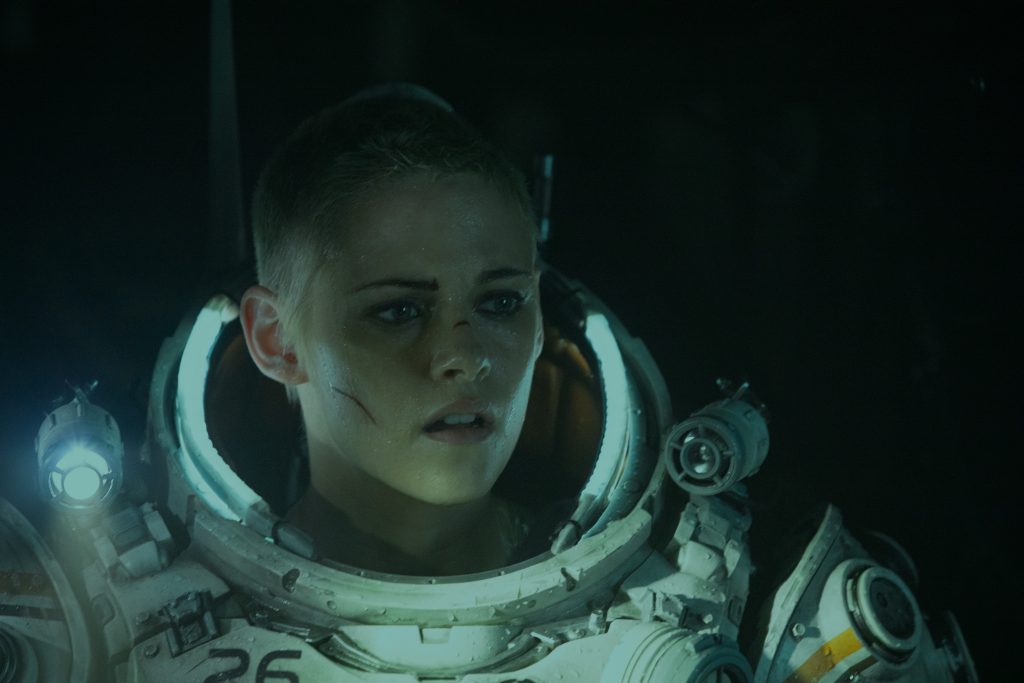October 4, 2020
by Carla Hay
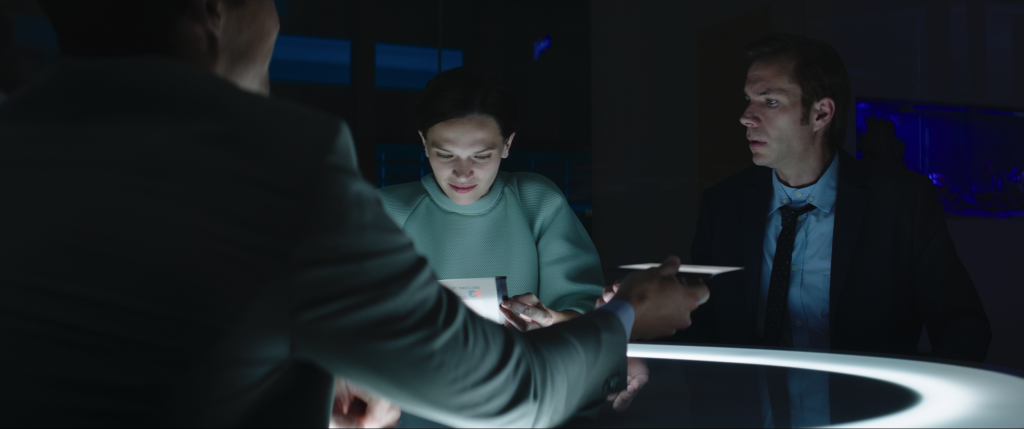
Directed by Guy Moshe
Culture Representation: Taking place in an unnamed U.S. city in the year 2048, the sci-fi drama “LX 2048” has a predominantly white cast of characters (with one black person) representing the middle-class.
Culture Clash: A terminally ill man, who works as a tech broker, has problems in his marriage and a life-insurance clause where he can be replaced by a clone.
Culture Audience: “LX 2048” will appeal to people who are interested in movies that explore the ethics and concepts of human cloning, but the movie’s main characters are not very easy to like.
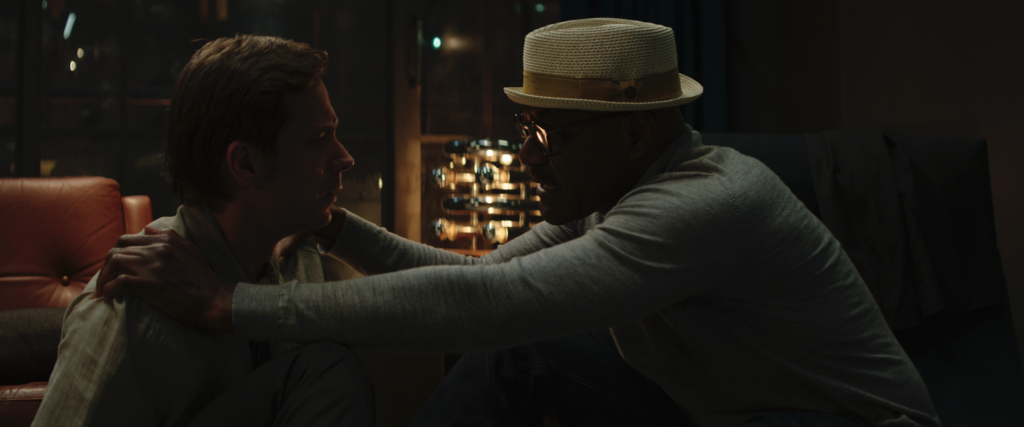
“LX 2048” takes several familiar sci-fi concepts—a dystopian future, next-level virtual reality, chip-implant technology and human cloning—and mashes them all up together in a movie that ultimately becomes scatter-brained and a hokey melodrama in its last few scenes. Written and directed by Guy Moshe, “LX 2048” is the equivalent of a chef’s meal that has too many ingredients and yet not enough distinctive substance to make it enjoyable. Although the film might have started out with good intentions, ultimately it fails to deliver a cohesive story and characters with memorable personalities.
“LX 2048” is centered on Adam Bird (played by James D’Arcy), a tech broker in his 40s, who has recently been diagnosed with a heart illness. The prognosis is grim: He has less than a year to live. The beginning of the movie shows Adam in the office of his physician Dr. Maple (played by Juliet Aubrey), who tells him this bad news: “You’re not dying yet. Your heart is definitely failing though.”
Dr. Maple tries to look on the bright side, because she reminds Adam that he’s on Premium 3 insurance, which is a life-insurance policy where someone agrees that after death, that person can be brought back as a clone by a loved one. The clones are not immortal, but this cloning gives the dead person’s loved ones the illusion that the dead person is still with them. Many of the “people” in this world of “LX 2048” are actually human clones who don’t have souls but can mimic human emotions. Dr. Maple is one of those clones.
Premium 3 insurance has an “upgrade” where a loved one can request that the human clone can have characteristics that the deceased loved one did not have. In other words, physical features and personality traits can be changed or erased, according to the wishes of the beneficiaries listed in the policy. The insurance agents recommend that beneficiaries do not tell the policy holders while they are still alive what they would change about them.
Adam’s health diagnosis isn’t the only depressing thing about his life. He lives in a world where the ozone layer has become so depleted that sunlight has become a danger to people’s health, so people rarely go outside in the daytime. Those that do go outside during the day, such as Adam, have to hear hazmat suits.
Mental depression has become very common in the world’s population, so the government has required that people take 001LithiumX, which is anti-depressant medication that is nicknamed LX. Adam is a nonconformist who refuses to take LX. He also insists on commuting to an office for his job, while almost all of his colleagues work remotely from their homes.
In addition, at the time that Adam has been told that he doesn’t have much longer to live, his marriage has fallen apart. He is separated from his wife Reena (played Anna Brewster), who lives with their three underage sons: Kenny (played by Dylan Pierce), who’s about 13 or 14 years old; Joshua (played by Ronin Zaki Moshe), who’s about 9 or 10 years old; and Nate, who’s about 6 or 7 years old (Majus Motiejus Prokopas). The Birds are a rare family, because in this world where the future is bleak, having three kids is considered a large brood.
For whatever reason, Adam and Reena have held off on signing their divorce papers. However, the movie has a flashback of Adam and Reena in happier times, when they were a couple and when both signed up for Premium 3 insurance. They have separate policies, where each spouse is the beneficiary of the other one’s policy. Whether or not an “upgrade” option is chosen has a lot to do with that happens later in the movie.
When Adam calls Reena to tell her that he’s dying and that he wants to arrange visitation with their children, viewers don’t hear what Reena says on the other line, but it angers Adam to the point where he curses at her and yells that all she cares about is paperwork. It’s later revealed in the story that Reena as a restraining order against Adam. “Fuck you!” he shouts at Reena before he hangs up phone on her.
It isn’t the first time that Adam shows that he has a bad temper. In a virtual-reality meeting with the board of directors at the company he works for, Adam (who is shown wearing virtual-reality goggles as he sits alone in a conference room) yells at the other people in the meeting. It’s because they won’t listen to his advice to divest from virtual reality and invest more in technology chips that can be implanted in people. Adam strongly believes that chip implants and chip installations are the future of technology.
“Bye bye, goggles,” Adam says at one point when he’s by himself. “Sooner or later, I’m going to be out a job.” The company that Adam works for is already struggling financially, and he worries that if the board members don’t follow his advice, the company will go bankrupt or go out of business. And that would put his Premium 3 life insurance policy, which he has through the company, in jeopardy.
Meanwhile, Reena grants Adam’s wish to see their kids, but the children are often unavailable to him because they’re “connected” to their devices. While Adam stays in a guest room, he begins having sex with a sex doll that is connected to a virtual-reality program that he uses. Reena catches him in the act and walks out of the room disgusted. Adam tries to apologize to Reena, but they get into an argument. Reena is very upset because the door was unlocked when she walked in, and she thinks it’s disrespectful that Adam would have sex in a way where any of the kids could possibly see him.
As the movie’s story unfolds, it turns out this other sex life that Adam has in his virtual-reality world is one of the main reasons why his marriage to Reena failed. Reena believes that Adam’s sexual “flings” in this virtual-reality world are infidelity in their marriage. Adam disagrees. And this disagreement reached a point where Reena demanded that Adam “disconnect” from this virtual sex life permanently, or else their marriage would be over.
Adam chose not to disconnect from virtual sex with other women. His current virtual-reality girlfriend Maria (played by Gabrielle Cassi) is about 20 years younger than Adam, and she looks like a typical fantasy blonde. Of course, because Adam has essentially created Maria in this virtual-reality world, she tells him everything he wants to hear to boost his ego and make him feel wanted. But there’s one big problem: Her emotions aren’t real. Adam hates to be reminded of this fact.
Meanwhile, the movie goes on another tangent where Adam tracks down a disgraced scientist named Donald Stein (played by Delroy Lindo), who has been “hiding” in a retirement home under the new name Jeremy Fisher. Dr. Stein has gone into hiding because he was ousted from his government job for making a clone of his virtual-reality lover. Adam idolizes Dr. Stein, whom Adam calls the “godfather of human cloning,”
The reason why Adam wants to meet with Dr. Stein is to tell the scientist that he found out that the skin of clones doesn’t get burned by sunlight because clones’ skin has “augmented pigmentation.” Adam wants to team up with Dr. Stein to figure out a way to transfer this type of skin protection to humans through chip technology, in order to make it safe for humans to go outside in daylight again, without having to wear hazmat suits. Dr. Stein is somewhat intrigued, but he’s reluctant to start doing scientific work again because he’s on some kind of government watch list. Dr. Stein suggests that Adam focus on getting a new heart.
One of the many plot holes of “LX 2048” is it never explains (probably because it’s so hard to believe) that Adam is the only person in this world who has figured out that clones’ skin doesn’t burn. It’s something that would’ve been discovered by many people and many clones already, based on how many clones have been living among humans in this world. And certainly, if Dr. Stein is so “brilliant” and the “godfather of human cloning,” he would have been one of the first people to know that clones’ skin could not get burned by sunlight. Dr. Stein wouldn’t need some random tech worker to tell him that, years after human clones were invented.
A more critical problem with “LX 2048” is that it overstuffs the movie with too many plots going on at the same time. There’s Adam’s terminal illness. There’s his marital discord. There’s his obsession with chip technology. There’s his quest to get Dr. Stein to work with him. And there’s a constant reference to this dystopian world having a serious addiction problem with people who are hooked on LX.
It’s a lot to try to pack in a 103-minute movie, unless the screenplay is well-written. Unfortunately, “LX 2048” isn’t a well-written movie, and it often loses its focus by trying to cover all of these plots. As a result, character development suffers. Adam, the main character, isn’t very likable or even a strongly unlikable anti-hero. He’s just mainly forgettable.
It seems as if writer/director Guy Moshe wants to make Adam sympathetic and heartbroken over Adam’s failed marriage, but Adam’s decision to choose virtual reality (in other words, fake relationships) over his own marriage with his real wife automatically will turn a lot off a lot of viewers from Adam. People aren’t going to be on Adam’s self-pity party train just because he’s been diagnosed with a terminal disease, when his actions show that he can be extremely self-centered and prone to temper tantrums that are bad enough that his estranged wife has a restraining order against him.
It’s also problematic the way that women are written in this movie. Reena is the only human woman in the story with a significant speaking role. The rest of the women with dialogue in the movie are either clones or are virtual-reality creations—in other words, they have no souls. If you were to believe what this movie presents as what a futuristic world looks like, only men are the leaders when it comes to science and new technology, and women have made no important contributions in these areas.
And even though Adam isn’t a great husband, Reena isn’t a great spouse either. She’s a bit of a shrew who seems money-hungry over Adam’s life-insurance policy and what Adam’s death would mean for her household income, since she’s a homemaker who doesn’t want any other job. To her credit, Reena seems to be more caring than Adam when it comes to protecting their children from the mean-spirited arguments that she and Adam have. However, Reena doesn’t seem very concerned that their kids are so addicted to technology that she doesn’t tell them to “disconnect” so they can spend quality time with their father when he comes to visit.
Dr. Stein isn’t in the movie very long, Adam doesn’t seem to work with any people outside of virtual reality, he doesn’t have any friends, and so viewers are stuck with mainly Adam and Reena (two unpleasant people) for most of the movie. After a while, viewers won’t really care much about what happens to Adam, Reena or this ex-couple’s miserable relationship. “LX 2048” has some interesting visual effects and set designs to depict this futuristic world, but nothing in this movie will be nominated for any major awards.
D’Arcy gives it his all in trying to portray Adam as a complex and flawed character. But unfortunately, the last few scenes in the movie are played in such an over-the-top manner, so that what started out as a serious sci-fi drama devolves into a soap opera. Sometimes, a movie’s plot holes can be forgiven if the characters are charismatic enough and the story is engaging enough for viewers to feel some kind of emotional connection. Unfortunately, “LX 2048” is so concerned with trying to dazzle the audience with sci-fi concepts that the people in the movie are as emotionally hollow as the human clones.
Quiver Distribution released “LX 2048” on digital and VOD on September 25, 2020.

